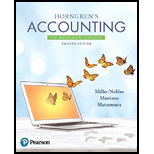
Concept explainers
Comprehensive Problem for Chapters 8, 9, and 10
Top Quality Application-Long Beach has just purchased a franchise from Top Quality Applance (TQA). TQA is a manufacturer of kitchen appliances. TQA markets is products via retail stores that are operated as franchises. As a TQA franchisee, Top Quality Appliance-Long Beach will receive many benefts, including having the exclusive right to sell TQA brand appiances in Long Beach. TQA appliances have an excellent reputation and the TQA name and logo are readily recognized by consumers. TQA also manages national television advertising campaigns that benefit the franchisees. In exchange for these benefts, Top Quality Appliance-Long Beach will pay an annual franchise tee to TQA based on a percentage at sales. The annual franchise tee is a separate cost and in addtion to the purchase of the franchise.
In addition to purchasing the franchise, Top Quality Appliance-Long Beach will also purchase land with an existing buiding to use for its retail store, store fixtures, and of?ce equipment. The business will purchase appliances from TQA and resell them in is store, primarilty to local building contractors for installation in new homes.
Following is the chart of accounts for Top Quality Appliance-Long Beach. As a new business, all beginning balances are $0.
| Top Quality Appliance—Long Beach |
Chart of Accounts
Top Quality Application—Long Beach completed the following transactions during 2018, its ?rst year of operations:
a. Received $500,000 cash from owner. T. Baker, in exchange for capital. Opened a new checking account at Long Beach National Bank and deposited the cash received from the owner.
b. Paid $50,000 cash lor a TQA franchise.
c. Paid $200,000 cash and issued a $400,000, l0-year, 5% notes payable for land with an existing building. The assets had the following marker vaiues: Land, $l00,000; Building, $500,000.
d. Paid $75,000 for store ?xtures.
e. Paid $45,000 tor ofice equipment.
f. Paid $600 for office supplies.
g. Paid $3,600 for a two-year insurance policy.
h. Purchased appliances irom TQA (merchandise inventory) on account for $425,000.
i. Established a petty cash fund for $150.
j. Sold applianceson account to 8&0 Contractors for $2l5,000. terms N30 (W61. 506.000)
k. Sold appliances to Davis Contracting for $150,000 (cost, $65,000), receiving a 6-month, 8% note.
l. Recorded credit card sales of $80,000 (cost, $35,000), net of processor fee of 2%.
m. Received payment in full from B&B Contractors.
n. Purchased appliances from TQA on account tor $650,000.
o. Made payment on account to TQA, $300,000.
p. Sold appliances for cash to LB Home Builders for $350,000 (cost. $175,000).
q. Received payment in full on the maturity date from Davis Contracting for the note.
r. Sold appliances to Leard Contracting for $265,000 (cost $130,000), receiving a 9-month, 8% note.
s. Made payment on account to TQA, $500,000.
t. Sold appliances on account to various businesses for $985,000, terms n/30 (cost. $395,000).
u. Collected $715,000 cash on account.
v. Paid cash for expenses: Salaries, $180,000; Utilltlet, $12,650
w. Replenished the petty cash fund when the fund had $62 in cath and petty cash tickets for $85 for office supplies.
x. Baker withdrew $5,000.
y. Paid the franchise fee to TQA of 5% of total sales of $2,045,000.
Requirements
2. Post to the general ledger.
Want to see the full answer?
Check out a sample textbook solution
Chapter 10 Solutions
Horngren's Accounting: The Managerial Chapters (12th Edition) (loose Leaf Version)
- Have you ever noted facework or saving face techniques being used in US-based companies (ones you have worked for or encountered in everyday life)? Explain and offer examples in your initial posting.arrow_forwardNeed correct answer general accountingarrow_forwardPlease solve this question general accountingarrow_forward
 Intermediate Accounting: Reporting And AnalysisAccountingISBN:9781337788281Author:James M. Wahlen, Jefferson P. Jones, Donald PagachPublisher:Cengage Learning
Intermediate Accounting: Reporting And AnalysisAccountingISBN:9781337788281Author:James M. Wahlen, Jefferson P. Jones, Donald PagachPublisher:Cengage Learning Managerial Accounting: The Cornerstone of Busines...AccountingISBN:9781337115773Author:Maryanne M. Mowen, Don R. Hansen, Dan L. HeitgerPublisher:Cengage Learning
Managerial Accounting: The Cornerstone of Busines...AccountingISBN:9781337115773Author:Maryanne M. Mowen, Don R. Hansen, Dan L. HeitgerPublisher:Cengage Learning College Accounting (Book Only): A Career ApproachAccountingISBN:9781337280570Author:Scott, Cathy J.Publisher:South-Western College PubCentury 21 Accounting Multicolumn JournalAccountingISBN:9781337679503Author:GilbertsonPublisher:Cengage
College Accounting (Book Only): A Career ApproachAccountingISBN:9781337280570Author:Scott, Cathy J.Publisher:South-Western College PubCentury 21 Accounting Multicolumn JournalAccountingISBN:9781337679503Author:GilbertsonPublisher:Cengage Cornerstones of Cost Management (Cornerstones Ser...AccountingISBN:9781305970663Author:Don R. Hansen, Maryanne M. MowenPublisher:Cengage Learning
Cornerstones of Cost Management (Cornerstones Ser...AccountingISBN:9781305970663Author:Don R. Hansen, Maryanne M. MowenPublisher:Cengage Learning





